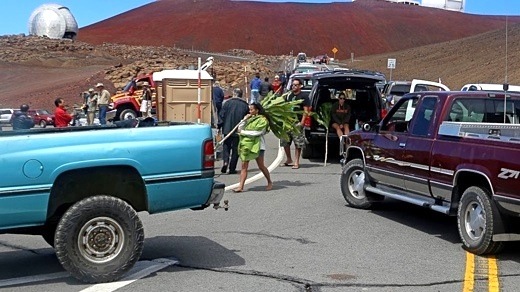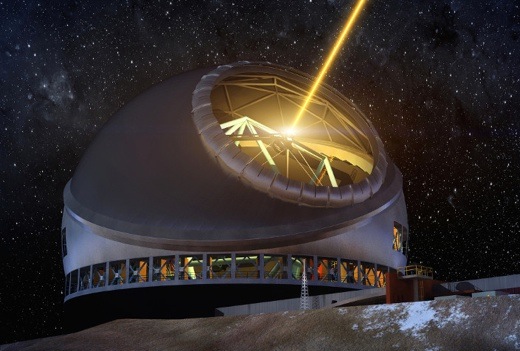SUBHEAD: Native Hawaiians stop groundbreaking ceremony with protest closing of access road on Big Island.
By Jennifer Sinco Kelleher on 8 October 2014 for Huffington Post -
(http://www.huffingtonpost.com/2014/10/08/mauna-kea-telescope-protest_n_5954894.html)

Image above: Protesters block vehicles from getting to the Thirty Meter Telescope groundbreaking ceremony site at Mauna Kea, Hawaii on Tuesday, Oct. 7, 2014. From ABC-TV News.
A groundbreaking and Hawaiian blessing ceremony came to an abrupt end before it could really get underway Tuesday because of protesters who oppose plans to build one of the world's largest telescopes near the summit of a mountain held sacred by Native Hawaiians.
More than an hour after the event was scheduled to begin near the top of the Big Island's Mauna Kea, the host of the ceremony's live webcast said the caravan carrying attendees up the mountain "hit a snag" and would be delayed. He later said the delay was due to a group of people blocking access to the site.
The groundbreaking for the $1.4 billion Thirty Meter Telescope was being shown via webcast because of limited access to the construction site, which is at an elevation of 14,000 feet with arctic-like conditions.
Stephanie Nagata, director of the Office of Mauna Kea Management, said several dozen protesters standing, sitting and chanting on the road prevented the caravan of vans from reaching the summit, but some passengers were able to walk the rest of the way to the ceremony.
The webcast later showed protesters yelling during attempts to start the blessing.
"We do hope we'll be able to find a common ground and proceed with this in the future," the webcast's host said before the broadcast was shut down.
The ceremony was interrupted by protesters holding signs and yelling, said Sandra Dawson, a spokeswoman for the telescope project.
"It was a ceremonial thing, and I don't know whether that will be repeated," she said. "We listened to the views of the people who were there. Everybody's in good spirits."
The disruption doesn't affect construction from moving forward, Dawson said.
Kealoha Pisciotta said her group, Mauna Kea Anaina Hou, planned to protest nonviolently by holding prayer ceremonies on the road at the bottom of the mountain. She said there were no plans to be disruptive or block people from attending the event.
Some in her group headed up the mountain to make an offering but encountered police blocking the road, Pisciotta said.
"They laid down on the road right there. That's what stopped the caravan," she said. "They were reacting to the police blocking the road."
Nagata said authorities did not block the road. A police spokeswoman didn't immediately return a call seeking information.
The groundbreaking was to culminate years of permit applications and approvals from the University of Hawaii and the state land board. The university leases land from the state where the telescope will be built. The Hawaii Board of Land and Natural Resources approved the sublease in June and then later denied requests to contest the approval.

Image above: A computer model of the Thirty Meter Telescope, which just began construction after more than a decade of planning. From (http://www.outsideonline.com/news-from-the-field/Hawaiian-Telescope-Construction-Begins-Amid-Controversy.html).
Opponents raised questions about whether land appraisals were done appropriately and whether Native Hawaiians were properly consulted.
Some protesters who yelled during the blessing attempt later apologized to event organizers and helped put away chairs, Pisciotta said. "We said aloha to each other and we hugged."
She said her group's leaders didn't intend to stop the ceremony.
"That wasn't anyone's goal," she said. "The organizers were very clear that we weren't trying to do that."
But, Pisciotta added, "We can't control everybody." She said no one was arrested.
The project was initiated by the University of California, California Institute of Technology and the Association of Canadian Universities for Research in Astronomy. Universities and institutions in China, India and Japan later signed on as partners.
The telescope should help scientists see some 13 billion light years away for a glimpse into the early years of the universe. Mauna Kea is the ideal location for observing the most distant and difficult to understand mysteries of the universe, astronomers said.
Its primary mirror promises to be 100 feet, or 30 meters, in diameter, made up of 492 smaller mirrors.
.
By Jennifer Sinco Kelleher on 8 October 2014 for Huffington Post -
(http://www.huffingtonpost.com/2014/10/08/mauna-kea-telescope-protest_n_5954894.html)

Image above: Protesters block vehicles from getting to the Thirty Meter Telescope groundbreaking ceremony site at Mauna Kea, Hawaii on Tuesday, Oct. 7, 2014. From ABC-TV News.
A groundbreaking and Hawaiian blessing ceremony came to an abrupt end before it could really get underway Tuesday because of protesters who oppose plans to build one of the world's largest telescopes near the summit of a mountain held sacred by Native Hawaiians.
More than an hour after the event was scheduled to begin near the top of the Big Island's Mauna Kea, the host of the ceremony's live webcast said the caravan carrying attendees up the mountain "hit a snag" and would be delayed. He later said the delay was due to a group of people blocking access to the site.
The groundbreaking for the $1.4 billion Thirty Meter Telescope was being shown via webcast because of limited access to the construction site, which is at an elevation of 14,000 feet with arctic-like conditions.
Stephanie Nagata, director of the Office of Mauna Kea Management, said several dozen protesters standing, sitting and chanting on the road prevented the caravan of vans from reaching the summit, but some passengers were able to walk the rest of the way to the ceremony.
The webcast later showed protesters yelling during attempts to start the blessing.
"We do hope we'll be able to find a common ground and proceed with this in the future," the webcast's host said before the broadcast was shut down.
The ceremony was interrupted by protesters holding signs and yelling, said Sandra Dawson, a spokeswoman for the telescope project.
"It was a ceremonial thing, and I don't know whether that will be repeated," she said. "We listened to the views of the people who were there. Everybody's in good spirits."
The disruption doesn't affect construction from moving forward, Dawson said.
Kealoha Pisciotta said her group, Mauna Kea Anaina Hou, planned to protest nonviolently by holding prayer ceremonies on the road at the bottom of the mountain. She said there were no plans to be disruptive or block people from attending the event.
Some in her group headed up the mountain to make an offering but encountered police blocking the road, Pisciotta said.
"They laid down on the road right there. That's what stopped the caravan," she said. "They were reacting to the police blocking the road."
Nagata said authorities did not block the road. A police spokeswoman didn't immediately return a call seeking information.
The groundbreaking was to culminate years of permit applications and approvals from the University of Hawaii and the state land board. The university leases land from the state where the telescope will be built. The Hawaii Board of Land and Natural Resources approved the sublease in June and then later denied requests to contest the approval.

Image above: A computer model of the Thirty Meter Telescope, which just began construction after more than a decade of planning. From (http://www.outsideonline.com/news-from-the-field/Hawaiian-Telescope-Construction-Begins-Amid-Controversy.html).
Opponents raised questions about whether land appraisals were done appropriately and whether Native Hawaiians were properly consulted.
Some protesters who yelled during the blessing attempt later apologized to event organizers and helped put away chairs, Pisciotta said. "We said aloha to each other and we hugged."
She said her group's leaders didn't intend to stop the ceremony.
"That wasn't anyone's goal," she said. "The organizers were very clear that we weren't trying to do that."
But, Pisciotta added, "We can't control everybody." She said no one was arrested.
The project was initiated by the University of California, California Institute of Technology and the Association of Canadian Universities for Research in Astronomy. Universities and institutions in China, India and Japan later signed on as partners.
The telescope should help scientists see some 13 billion light years away for a glimpse into the early years of the universe. Mauna Kea is the ideal location for observing the most distant and difficult to understand mysteries of the universe, astronomers said.
Its primary mirror promises to be 100 feet, or 30 meters, in diameter, made up of 492 smaller mirrors.
.
No comments :
Post a Comment